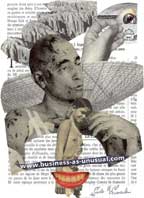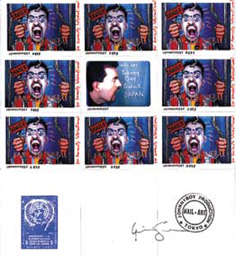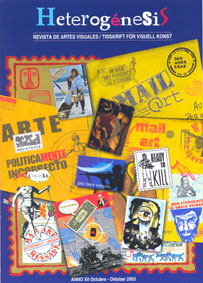 |
|
Network
conversations between 2 G’s
|
 |
| Gianni
Simone:I
remember that when I joined the mail art network, in 1997, there were
two main debates going on. One was about the growing role of the electronic
media in the everyday correspondence among artists: some people argued
that the days of the so-called “snail mail” were counted and
eventually it would have been totally replaced by the e-mail. The other
debate was even more ambitious in scope and concerned the very role of
mail art at the end of the Millennium. It seems that every once in a while,
someone decides that mail art is dead or about to die; that it has become
an obsolete form of expression and it has betrayed its original values.
This year you celebrate your first ten years of mail arting, and I am
sure that in all this time, you have experienced many changes, both in
your activity and the Network in general. |
Guido Vermeulen: My own evolution reflects the debate in the network. I only started networking thru’ Internet and email in 2001. It coincided with the first visit of Lavona Sherarts to Belgium. From 1993 to that period my own activities were limited to snail mail, if limited is a correct word to describe these activities. I watched and commented the existence of 3 groups. The first one I call “purists”. Mail art is only possible by regular mail. Why? There is no real answer on that question but lots of fake arguments instead. Some people always argue about a definition of mail art. Definition here is understood only as a limiting and reductive principle. The reasoning you often hear is “yes, that’s nice but is it mail art?” Who cares! The declarations on “mail art is dead” are often linked to these narrowing definition obsessions. Mail art is dead when mail art does not correspond anymore to my idea of mail art or mail art is dead when I decided to quit because… In both cases the megalomania of the ego is quite evident. A second group of people dropped snail mail, embraced the computer and vanished as correspondents. I found this attitude bizarre, to say the least. Not everyone has a computer or Internet facilities. You have to possess the financial resources to make the step and acquire the knowledge to work with a PC and to solve a series of problems. I found the group of people who suddenly swore by the computer and the computer only quite elitist and in contradiction with the democratic aspect of mail art because mail art was and still is the most democratic form and movement of expression of art that has developed since modern art gave birth to the idea of “correspondence art”. On an artistic level I am quite old-fashioned in the sense that I need a contact with the material(s) I use to express ideas or fantasies: working with real paint, ink, papers gives me a kick. Making art with a computer is quite sterile for me. You don’t have the same direct relation with the materials anymore. But I agree that others can have a kick from computer art. It’s just not my thing. This blocked me for a long time. A third group was active in both PC and snail mail communication. The computer became an extension of mail art possibilities and networking. That seduced me and finally I made the investment and started networking with the PC as well. For me the aspect of communication was even more important than in regular mail art. This in a way is also how I altered my views on mail art in the last decade. I entered the mail art network as an artist (poet, painter, etcher, collagist) who spread around his artwork to others, to projects and to individual correspondents who became friends “on the road” of exchanges. What became more important were these exchanges and the fact that we could do things together and learn each other’s ideas and visions. What quickly became the main focus was how to expand this network and reach as many people as possible in all continents of the globe. Art was only a tool to reach others. So gradually I became a network artist and I saw mail art more as the art of communication than the communication of art. Of course this shift that happened during a decade of activities finally drove me to embrace computer technology as a tool of communication because it is faster and more efficient and wider than snail mail. Today I don’t talk about mail art anymore. I call it network art or networked art and you can do it with the PC, in the mail, or “live” (personal meetings and collaborations). I feel backed in this new perception of mail art by the recent publication of Saper for instance.1 |
 |
|
GS: I agree with your point of view. I must confess that I’m quite old-fashioned and for a long time I resisted the idea of embracing e-mail communication. But last year I finally gave it a try and it proved decisive when I decided to devote an issue of my zine KAIRAN to the mail art scene in Latin America. In that occasion I had to face a number of problems that made me look at correspondence and communication with different eyes. For example, until recently I believed that the post was the cheapest and most democratic way of networking around the world. After all, as you pointed out above, not everybody can afford to buy a computer or has Internet access. But in working with the Latin American mail artists, I not only found out that most of these people worked with a computer every day, but that for many of them, the e-mail was the only feasible way to correspond frequently. The problem is, in many Central and South American countries, globalization has been a disaster and has badly damaged the lives of millions of people. As everybody knows, Argentina is the place that has suffered the most and one of the consequences of this economic debacle has been that even sending a letter abroad has become too expensive for most people. That is why in the last twelve months the usually massive Argentinean presence in the Network has been very limited and the e-mail has remained their only link with the world. These recent developments highlight what I consider another “structural” problem of our Network, that has already been analysed in the last years, namely by Matt F. with his Dead White Mail project in 1999 (see www.spareroom.org/mailart/mailart.html), The Sticker Dude (A Question of Balance, in KAIRAN 3, May 2001) and myself (A Question of Style?, in KAIRAN 4, Nov. 2001): the fact that even though it’s true, as you said, that mail art is the most democratic form of artistic expression, the theoretical openness of the Network clashes with a number of economic and cultural factors that prevent a greater number of people from participating. Indeed, it’s no mystery that mail art activity is concentrated in North America and Western Europe, while the African and Asian presence – with Japan as the only exception – is almost non-existent. The risk, therefore, is that the Network becomes a sort of golden ghetto for affluent people who want to “play the artist”. In this respect, I find that the e-mail has the power and capability to break many barriers, e.g. helping mail art to reach out to other like-minded networks. I think that your recent participation in the World Peace Poem project and the launch of FRIOUR NETWORK MAGAZINE are a good example of the many options we have to expand our activity. |
GV: The demand to help to develop a chain of poems against the war in Iraq was for me in fact also a first realization of the capacities of the email and Internet medium. The World Peace Poem came together quickly, on a few weeks time in fact. Tais Lintz, a Brazilian woman living in Canada, asked for my assistance and editing of the whole chain. I was amazed that we realized this within this time framework. The poems were published on websites in Germany and in Brazil. I found that this effort should be documented in a publication. Instead of making a single one I decided that this could be the start of a new network magazine. I was thinking about this for quite some time but felt unhappy that it would be limited to mail art. Because the World Peace Poem was the result of the meeting of different networks - mail art and poetry networks; art & peace networks; anti globalization networks - I suddenly saw the light. The zine would be a network magazine, the result of crossovers between different networks and a shared zine, meaning that several editors from these different network environments could make an issue around a theme. The email & Internet opened my eyes for all these possibilities and for all these different networks that are extremely active. This is another approach to globalization: against the economic globalization based on global exploitation of the planet we can put our own globalization, networks are spreading around like mushrooms, giving us information we are lacking in our media, spreading art and peace solutions around, calling for action based on information, supporting each other’s efforts and so on. So often is said “Think global and act local”. Yes, sure, but act on a global scale as well. That’s becoming possible now because of all this email communication. The anti globalization (or other, different globalization) movement is a good example of this. The peace demonstrations in February & March where millions of people demonstrated the same weekend all over the world is another. That kind of coordination of efforts is impossible without the Internet and email communication. So suddenly I realized the potential. Yes, we can globalize too in opposition, in unity, in art, in peace, against those forces in the world who only want domination of the planet and create misery, war, exploitation, human rights violations to obtain their perfidy goals. I was quite happy at last that I was able to communicate with people from Africa, from the Middle East, from Asia (not only Japan, I mean) and these people I met as networkers outside mail art. They were active in other networks: poetry, creative writing, art of refugees, Transcend Art & Peace networks. TAP2 was perhaps the biggest discovery for me and it is a network where I feel at ease and that opened its site also for mail art. So crossovers are really happening on various levels. It’s also a TAP member that will produce the 3d issue of FRIOUR and she has developed her own site that wants to reflect on peace and literature3 |
|
GS:
I
don’t know if it has just been a coincidence, but the dramatic
surge in war and violence after the fall of the World Trade Center in
New York, has been followed by an unusually high number of mail art
projects with a social and political theme. Just to name a few, we have
had Peace in the World (Brazil); The Fire That Doesn’t Fade (Brazil),
against pollution and the destruction of the environment; Difference
(France), about sexism, racism and other kinds of discrimination; Without
Artists, Borders (Spain); Immigration (Costa Rica); Cornucopia (Belgium),
which questioned “the ongoing demolition of our society”;
Pied Pipers of Today (Germany), about “the fake seducers of the
modern world”; the ongoing Nobel Peace Project (Canada); and Black
Tide (Spain), in support of the protests against the indifference of
the authorities following the sinking of yet another oil tanker near
the Galician coasts.
|
GV:
Art
can create awareness, that’s for sure. Sometimes art is born from
awareness, so it goes 2 ways. For instance the DADA movement was a rebelling
baby that stood up from the trenches of world war one. Artists have
visions that are not tempered by the real politic of society. They often
see through the mirror and hypocrisy of oppressive language, they crack
the codes of veiled realities. They connect people by allowing glimpses
in other cultures. They invent new codes, they liberate the page and
the framework of the canvas, so they liberate views or incite to look
upon realities a different way and so on. You have those who reject this. For them art is about inventiveness and that’s it. The most crazy and/ or original project are preferred above social themes. I don’t mind this. I can read beauty in most projects. For instance a few years ago there was a call to send art to Abe. Abe was the goldfish of a girl and she wanted to decorate the fish tank with mail art, so her fish could see art and parts of the world. Only a few people responded to her message. I was one of them because the call touched me. Communication with a fish, that’s pure poetry, man. Of course I would not invest myself in such a project when people in another country are targeted with cluster bombs. But that’s me. Maybe this could be a tragicomic conclusion: it’s easier and more rewarding to communicate with an American fish than with the president of the USA. Excuse me, but now I stop babbling and will talk more to the Blackbirds befriending my garden. |
 |

